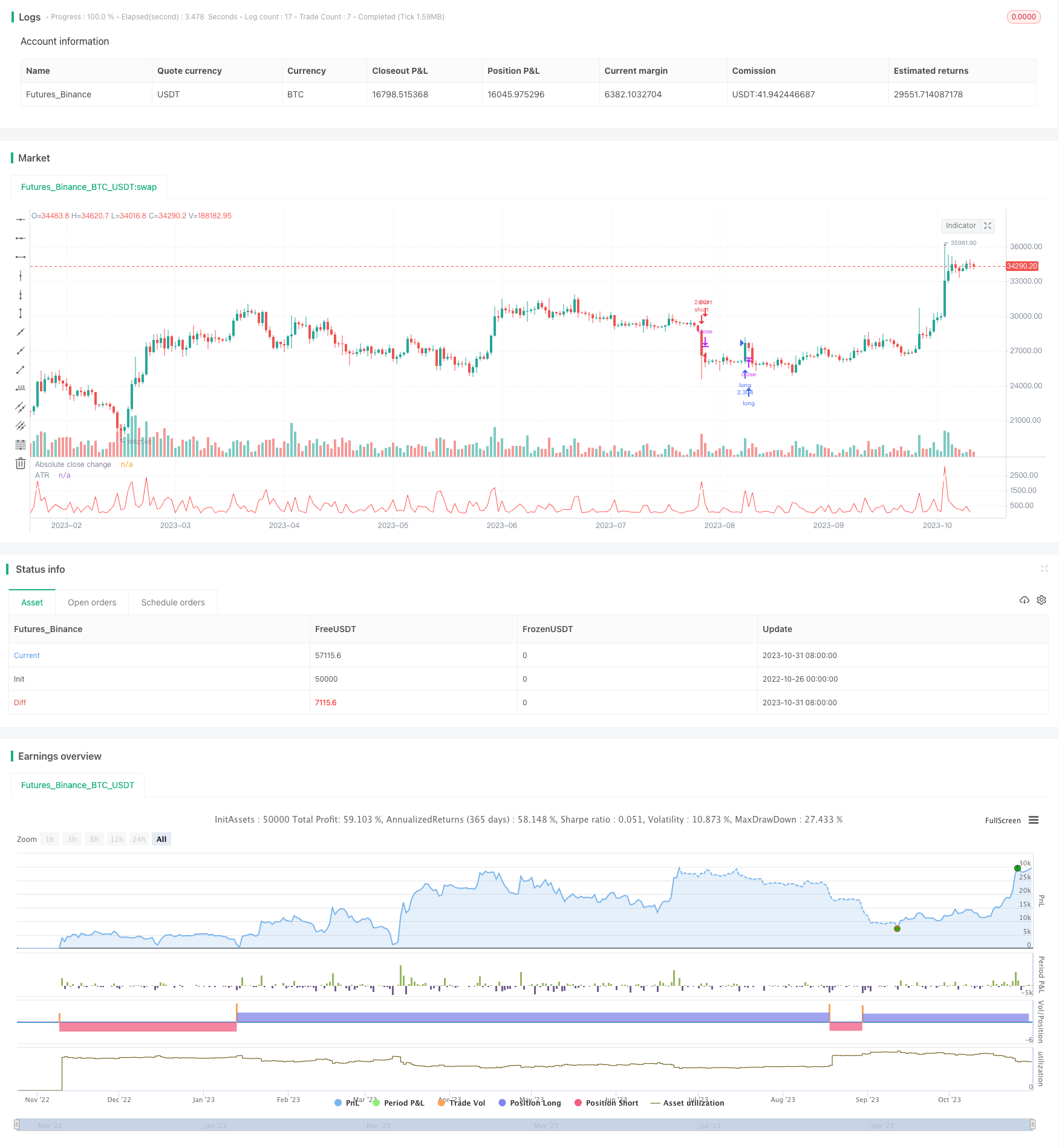Richard Bookstaber Momentum Breakout Strategy
Author: ChaoZhang, Date: 2023-11-02 15:12:46Tags:

Overview
The momentum breakout strategy is based on the concept proposed by Richard Bookstaber in 1984 that once there is a big volatile movement, the market tends to follow it. Thus, it uses the ATR to measure volatility and issues orders when the current change in the closing price exceeds the threshold calculated by multiplying the ATR by a configurable constant.
Strategy Logic
The strategy first calculates the ATR indicator to measure market volatility. Then it calculates the absolute value of the daily closing price change. When the closing price change exceeds the ATR value by several multiples, trading signals are generated. Specifically, if the closing price rises more than the ATR upper rail, go long; if the closing price falls more than the ATR upper rail, go short.
The strategy uses the ATR indicator to dynamically determine the breakout threshold. When market volatility increases, the threshold will rise to reduce erroneous trades. When market volatility decreases, the threshold will decrease to capture breakout opportunities in a timely manner.
Advantage Analysis
- Dynamic ATR stop loss can effectively control risks with adaptive stop loss based on market volatility.
- Using breakouts to generate trading signals can capture market trend rotations.
- Large parameter optimization space, can be adjusted for different products and cycles.
- The strategy logic is simple and clear, easy to understand and implement.
Risk Analysis
- ATR indicator reacts slowly to sudden events, may miss the initial breakout.
- Imbalanced between long and short, works significantly better for one side only than for two-way trading.
- Strategy parameters are easy to overfit, actual results may be poor.
- Frequent trading, transaction costs may be high.
Consider combining other indicators to select trading opportunities to improve efficiency. Also select optimal parameters based on product characteristics. Use techniques like Martingale to control trading frequency.
Optimization Directions
- Consider combining other indicators like RSI, MACD to determine trend direction and avoid wrong trades.
- Can add position management module to adjust positions based on market conditions.
- Can select optimal parameter sets for different products.
- Can combine machine learning techniques to auto-optimize parameters.
Summary
The momentum breakout strategy is simple and direct, generating trading signals from breakouts. ATR stop loss allows it to adapt to market volatility. The strategy relies on parameter optimization for decent results. But there are also some problems like missing initial breakouts, frequent trading, etc. Further improvements by combining with other techniques are needed for stable profits in complex markets. Overall, the momentum breakout strategy has clear logic and is worth further research and application.
/*backtest
start: 2022-10-26 00:00:00
end: 2023-11-01 00:00:00
period: 1d
basePeriod: 1h
exchanges: [{"eid":"Futures_Binance","currency":"BTC_USDT"}]
*/
// This source code is subject to the terms of the Mozilla Public License 2.0 at https://mozilla.org/MPL/2.0/
// © EduardoMattje
//@version=5
strategy("Volatility System", overlay=false, margin_long=0, margin_short=0, default_qty_type=strategy.percent_of_equity,
default_qty_value=100, process_orders_on_close=true, initial_capital=20000)
// Inputs
var averageLength = input.int(14, "Average length", 2)
var multiplier = input.float(2.0, "Multiplier", 0.0, step=0.1)
// Calculations
atr = ta.atr(averageLength) * multiplier
closingChange = ta.change(close, 1)
atrPenetration(int signal) =>
res = closingChange * signal > atr[1]
longCondition = atrPenetration(1)
shortCondition = atrPenetration(-1)
// Order calls
if (longCondition)
strategy.entry(strategy.direction.long, strategy.long)
if (shortCondition)
strategy.entry(strategy.direction.short, strategy.short)
// Visuals
plot(atr, "ATR", color.white, 2)
plot(math.abs(closingChange), "Absolute close change", color.red)
- Two-Stage Breakout Strategy
- Relative Strength Index RSI Strategy
- Bollinger Band T3 Moving Average Strategy
- BB Dual Long and Short Trading Strategy
- Mean Reversion Breakout Low Strategy
- Dual Indicator Strategy
- EVWBB Strategy Based on EVWMA and Bollinger Bands
- MACD Trend Prediction Strategy
- Moving Average Ribbon Trend Strategy
- CCI and EMA Trend Following Trading Strategy
- Dual Moving Average Strategy
- Adaptive Moving Average Channel Breakout Strategy
- Momentum Swing Effective Profit Strategy
- Hull Moving Average Trend Following Strategy
- RSI Daredevil Squadron Fusion Strategy
- Triple Moving Average Trading Strategy
- Prime Number Oscillator Trading Strategy
- Momentum Breakout Identifies Strategy
- Triple RSI Extremum Trading Strategy
- Golden Cross Keltner Channel Trend Following Strategy